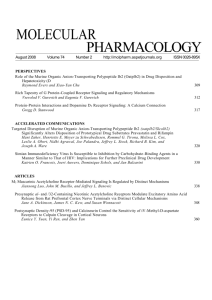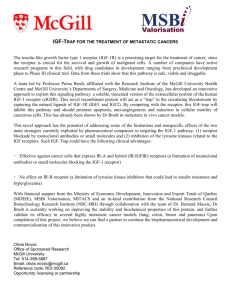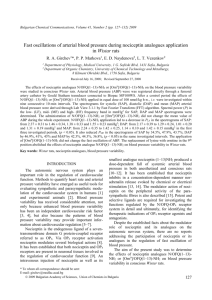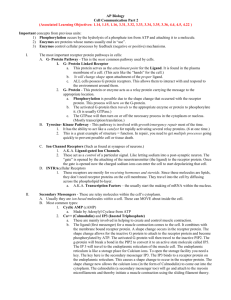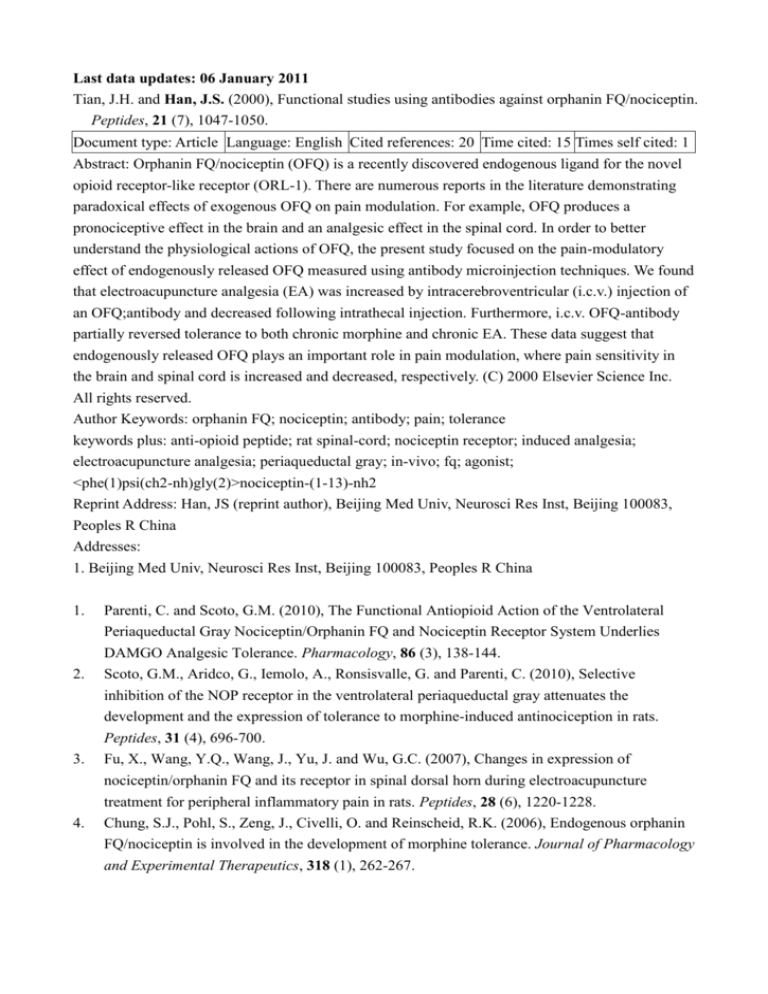
Last data updates: 06 January 2011
Tian, J.H. and Han, J.S. (2000), Functional studies using antibodies against orphanin FQ/nociceptin.
Peptides, 21 (7), 1047-1050.
Document type: Article Language: English Cited references: 20 Time cited: 15 Times self cited: 1
Abstract: Orphanin FQ/nociceptin (OFQ) is a recently discovered endogenous ligand for the novel
opioid receptor-like receptor (ORL-1). There are numerous reports in the literature demonstrating
paradoxical effects of exogenous OFQ on pain modulation. For example, OFQ produces a
pronociceptive effect in the brain and an analgesic effect in the spinal cord. In order to better
understand the physiological actions of OFQ, the present study focused on the pain-modulatory
effect of endogenously released OFQ measured using antibody microinjection techniques. We found
that electroacupuncture analgesia (EA) was increased by intracerebroventricular (i.c.v.) injection of
an OFQ;antibody and decreased following intrathecal injection. Furthermore, i.c.v. OFQ-antibody
partially reversed tolerance to both chronic morphine and chronic EA. These data suggest that
endogenously released OFQ plays an important role in pain modulation, where pain sensitivity in
the brain and spinal cord is increased and decreased, respectively. (C) 2000 Elsevier Science Inc.
All rights reserved.
Author Keywords: orphanin FQ; nociceptin; antibody; pain; tolerance
keywords plus: anti-opioid peptide; rat spinal-cord; nociceptin receptor; induced analgesia;
electroacupuncture analgesia; periaqueductal gray; in-vivo; fq; agonist;
<phe(1)psi(ch2-nh)gly(2)>nociceptin-(1-13)-nh2
Reprint Address: Han, JS (reprint author), Beijing Med Univ, Neurosci Res Inst, Beijing 100083,
Peoples R China
Addresses:
1. Beijing Med Univ, Neurosci Res Inst, Beijing 100083, Peoples R China
1.
2.
Parenti, C. and Scoto, G.M. (2010), The Functional Antiopioid Action of the Ventrolateral
Periaqueductal Gray Nociceptin/Orphanin FQ and Nociceptin Receptor System Underlies
DAMGO Analgesic Tolerance. Pharmacology, 86 (3), 138-144.
Scoto, G.M., Aridco, G., Iemolo, A., Ronsisvalle, G. and Parenti, C. (2010), Selective
inhibition of the NOP receptor in the ventrolateral periaqueductal gray attenuates the
development and the expression of tolerance to morphine-induced antinociception in rats.
3.
Peptides, 31 (4), 696-700.
Fu, X., Wang, Y.Q., Wang, J., Yu, J. and Wu, G.C. (2007), Changes in expression of
nociceptin/orphanin FQ and its receptor in spinal dorsal horn during electroacupuncture
4.
treatment for peripheral inflammatory pain in rats. Peptides, 28 (6), 1220-1228.
Chung, S.J., Pohl, S., Zeng, J., Civelli, O. and Reinscheid, R.K. (2006), Endogenous orphanin
FQ/nociceptin is involved in the development of morphine tolerance. Journal of Pharmacology
and Experimental Therapeutics, 318 (1), 262-267.
5.
6.
Ozsoy, H.Z., Thakker, D.R. and Standifer, K.M. (2005), Orphanin FQ/nociceptin potentiates
[D-Ala(2),N-Me-Phe(4),Gly(5)-ol]-enkephalin-induced mu-opioid receptor phosphorylation.
Molecular Pharmacology, 68 (2), 447-456.
Mollereau, C., Roumy, M. and Zajac, J.M. (2005), Opioid-modulating peptides: Mechanisms
7.
of action. Current Topics in Medicinal Chemistry, 5 (3), 341-355.
Ray, S.B., Gupta, Y.K. and Wadhwa, S. (2005), Expression of opioid receptor-like 1(ORL1) &
mu opioid receptors in the spinal cord of morphine tolerant mice. Indian Journal of Medical
8.
Research, 121 (3), 194-202.
Ma, F., Xie, H., Dong, Z.Q., Wang, Y.Q. and Wu, G.C. (2004), Effects of electroacupuncture
on orphanin FQ immunoreactivity and preproorphanin FQ mRNA in nucleus of raphe magnus
9.
in the neuropathic pain rats. Brain Research Bulletin, 63 (6), 509-513.
Faulhammer, D., Eschgfaller, B., Stark, S., Burgstaller, P., Englberger, W., Erfurth, J.,
Kleinjung, F., Rupp, J., Vulcu, S.D., Schroder, W., Vonhoff, S., Nawrath, H., Gillen, C. and
Klussmann, S. (2004), Biostable aptamers with antagonistic properties to the neuropeptide
nociceptin/orphanin FQ. Rna-A Publication of the Rna Society, 10 (3), 516-527.
10. Simonnet, G. and Rivat, C. (2003), Opioid-induced hyperalgesia: abnormal or normal pain?
Neuroreport, 14 (1), 1-7.
11. Han, J.S. (2003), Acupuncture: neuropeptide release produced by electrical stimulation of
different frequencies. Trends in Neurosciences, 26 (1), 17-22.
12. Gavioli, E.C., Rae, G.A., Calo, G., Guerrini, R. and De Lima, T.C.M. (2002), Central
injections of nocistatin or its C-terminal hexapeptide exert anxiogenic-like effect on behaviour
of mice in the plus-maze test. British Journal of Pharmacology, 136 (5), 764-772.
13. Romualdi, P., Landuzzi, D., D'Addario, C. and Candeletti, S. (2002), Modulation of
proorphaninFQ/N gene expression by morphine in the rat mesocorticolimbic system.
Neuroreport, 13 (5), 645-648.
14. Vaccarino, A.L. and Kastin, A.J. (2001), Endogenous opiates: 2000. Peptides, 22 (12),
2257-2328.
15. Slowe, S.J., Clarke, S., Lena, I., Goody, R.J., Lattanzi, R., Negri, L., Simonin, F., Matthes,
H.W.D., Filliol, D., Kieffer, B.L. and Kitchen, I. (2001), Autoradiographic mapping of the
opioid receptor-like 1 (ORL1) receptor in the brains of mu-, delta- or kappa-opioid receptor
knockout mice. Neuroscience, 106 (3), 469-480.


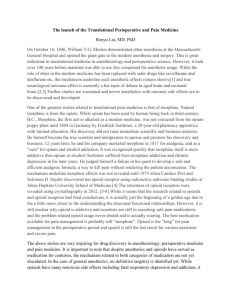

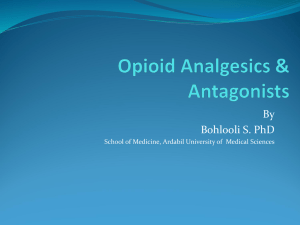
![Shark Electrosense: physiology and circuit model []](http://s2.studylib.net/store/data/005306781_1-34d5e86294a52e9275a69716495e2e51-300x300.png)

